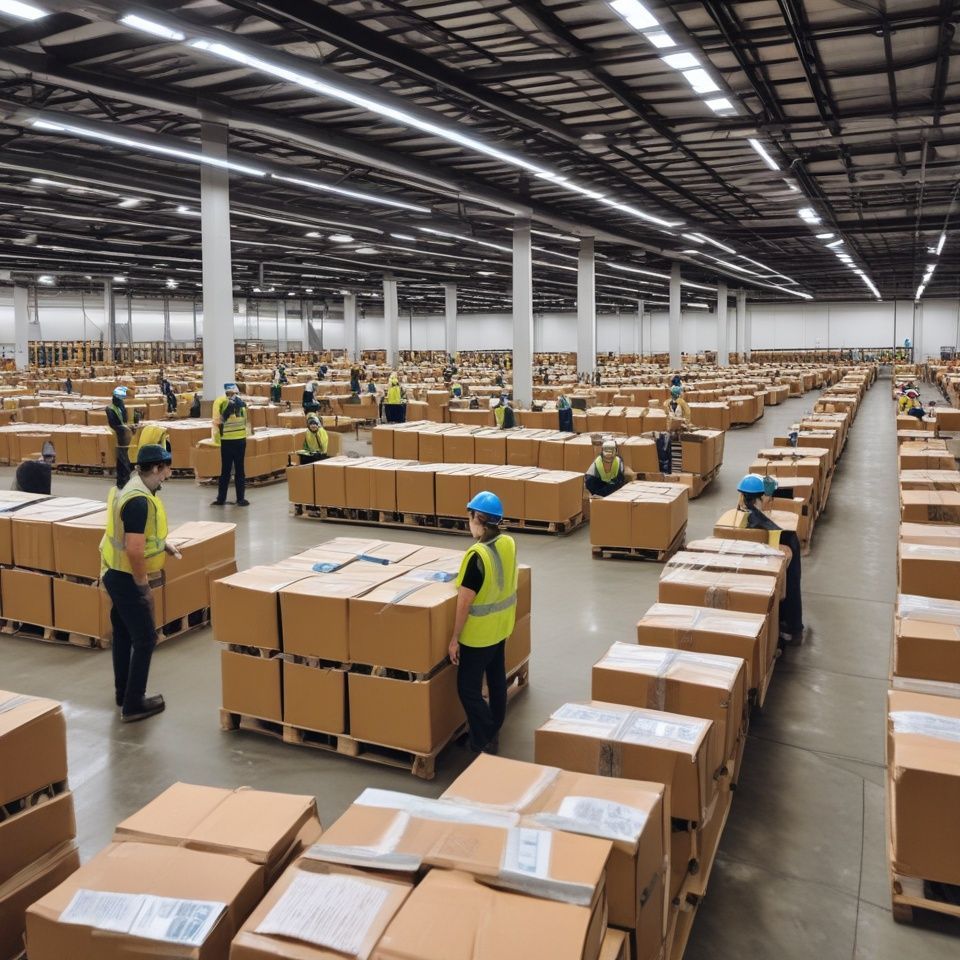Workforce Management Optimization in Supply Chain & Warehousing: Driving Efficiency from Dock to Doorstep
Brennan Jackson • June 3, 2025
This is a subtitle for your new post

The supply chain and warehousing sectors are the backbone of global commerce, but rising consumer expectations, labor shortages, and volatile demand have made operational efficiency more critical than ever. Workforce management optimization (WFM) isn’t just about filling shifts—it’s about aligning people, processes, and technology to keep goods moving smoothly, reduce costs, and meet delivery deadlines. Here’s how WFM optimization transforms supply chain and warehousing operations.
Why Workforce Management is a Game-Changer for Supply Chain & Warehousing
In warehouses and distribution centers, labor costs can account for up to 70% of operational expenses. With tight margins and pressure for faster order fulfillment, optimizing workforce productivity isn’t optional—it’s survival. Effective WFM ensures that workers are strategically deployed across receiving, picking, packing, and shipping tasks while minimizing downtime and errors. It’s the key to balancing fluctuating order volumes, seasonal peaks (like holiday rushes), and unpredictable disruptions (e.g., supply delays).
Unique Workforce Challenges in Supply Chain & Warehousing:
- Demand Volatility: Sudden spikes in orders or supplier delays create staffing chaos.
- Labor-Intensive Processes: Manual picking/packing and physically demanding work increase fatigue and turnover.
- Skill Gaps: Specialized roles (e.g., forklift operators, inventory analysts) require targeted training and scheduling.
- Safety Compliance: Strict OSHA regulations and warehouse safety protocols demand meticulous oversight.
- Real-Time Inventory Sync: Disconnects between workforce schedules and inventory flow lead to bottlenecks.
How Workforce Management Optimization Addresses Supply Chain Pain Points:
Modern WFM solutions tailored for supply chain and warehousing combine automation, IoT, and data analytics to streamline operations. Here’s how:
1. Demand-Driven Staffing with AI
- AI analyzes historical sales data, supplier lead times, and market trends to forecast staffing needs. For example, if a retailer’s promo campaign is expected to triple orders next week, the system schedules extra pickers and packers in advance.
2. Task Prioritization and Zone-Based Scheduling
- Smart tools assign workers to high-priority zones (e.g., perishables, fast-moving SKUs) based on real-time order urgency. This reduces cross-docking errors and speeds up fulfillment.
3. Fatigue Management and Shift Rotation
- Automated systems monitor worker hours and physical strain, rotating staff between high-intensity and lighter tasks to prevent burnout and injuries.
4. Integrated Inventory-Workforce Visibility
- Connect WFM platforms with warehouse management systems (WMS) to align labor schedules with inbound/outbound inventory flows. If a shipment arrives late, managers can instantly reassign workers to avoid idle time.
5. Mobile Tools for Agile Adjustments
- Equip floor managers and staff with apps to handle shift swaps, track task progress, or report safety issues in real time—critical for 24/7 operations.
6. Compliance Automation
- Ensure adherence to safety protocols and labor laws (e.g., break times, equipment certifications) with automated alerts and audit trails.
Benefits for Supply Chain & Warehousing:
- Reduced Labor Costs: Eliminate overstaffing during slow periods and optimize overtime.
- Faster Order Cycle Times: Align labor with order priorities to meet same-day shipping goals.
- Lower Error Rates: Assign skilled workers to complex tasks, reducing mispicks and returns.
- Improved Safety: Proactively manage workload distribution to prevent accidents.
- Scalability: Easily ramp up temporary workers during peak seasons without disrupting workflows.
Case in Point: Optimizing a 3PL Warehouse:
A third-party logistics (3PL) provider used AI-powered WFM to tackle seasonal demand swings. By integrating demand forecasting with real-time labor allocation, they reduced labor costs by 18%, improved on-time shipments by 25%, and cut employee turnover through smarter shift rotations.
The Role of Technology in Modern Warehousing:
Platforms like Clarity WOS offer supply chain-specific WFM tools, such as:
- IoT Integration: Track worker movements and inventory flow via RFID or sensors.
- Predictive Analytics: Anticipate equipment maintenance needs to avoid downtime.
- Cross-Functional Dashboards: Unify data from WMS, transportation, and labor systems for end-to-end visibility.
Conclusion: Building a Resilient Supply Chain Workforce
In an era where “delivery speed” defines competitive advantage, workforce management optimization is the linchpin of supply chain success. By leveraging AI, automation, and employee-centric scheduling, businesses can turn labor from a cost into a strategic asset—ensuring goods move faster, safer, and smarter from warehouse shelves to customers’ doors.
Ready to Revolutionize Your Supply Chain Workforce?
Discover how tailored WFM solutions can transform your warehousing operations. Visit Clarity WOS to learn more about optimizing your workforce for the demands of modern logistics.
Clarity-WOS by Top Hat Engineering | Powering Smarter Supply Chains

In an era defined by rapid market changes and escalating customer expectations, efficient inventory management has transcended from a mere operational task to a critical strategic imperative. Businesses globally are relentlessly pursuing innovative strategies to optimize their supply chains, curtail operational expenditures, and achieve unparalleled visibility across their entire enterprise. At the core of this transformation lies the potent solution of automated inventory systems. Leading this charge is Clarity's Clear Slot module, a groundbreaking innovation developed by the experts at Top Hat Engineering. Clear Slot isn't just another software; it's a comprehensive ecosystem engineered to streamline and elevate every facet of your inventory workflow. By intelligently automating crucial inventory tasks, precisely optimizing stock levels, and providing an extraordinary level of visibility, Clear Slot empowers your operation to achieve peak performance. Unlocking Unprecedented Efficiency: Key Benefits of Automating with Clear Slot The transition from manual or semi-automated inventory processes to a fully automated system with Clear Slot yields a multitude of tangible benefits that directly impact your bottom line and operational agility: Intelligent Automation of Routine Tasks: Bid farewell to the laborious, error-prone manual processes that often plague traditional inventory management. Clear Slot automates a vast array of essential tasks, including real-time stock tracking, automated replenishment triggers, precise inventory adjustments, and efficient cycle counting. This intelligent automation drastically reduces the potential for human error, minimizes data entry mistakes, and liberates your valuable personnel to concentrate on more strategic initiatives that require human ingenuity and decision-making. The result is not just increased efficiency, but also significantly enhanced data accuracy that forms the foundation for reliable business insights. Optimized Cross-Docking and Seamless Dock-to-Stock Operations: The bottleneck at the loading dock can significantly impede throughput and inflate operational costs. Clear Slot eliminates guesswork and delays from your inbound logistics. Through sophisticated algorithms and real-time data integration, the system intelligently assigns incoming inventory to the most appropriate locations. Whether it's direct cross-docking for immediate shipment or efficient assignment to specific warehouse slots, Clear Slot ensures goods move swiftly and efficiently from the moment they arrive to their final destination, minimizing dwell time and maximizing your warehouse's flow. Proactive Low Inventory Alerts: Preventing Costly Stockouts: The impact of a stockout extends far beyond a single lost sale; it can damage customer loyalty, disrupt production schedules, and even lead to emergency expedited shipping costs. Clear Slot’s proactive, automated alert system is your early warning mechanism. It continuously monitors stock levels against predefined thresholds and instantly notifies you when inventory is running low. This foresight empowers you to take decisive action before any shortages affect your operations, ensuring consistent product availability and uninterrupted customer service. Enhanced Data Visualization for Strategic Insights: Knowledge is power, and in inventory management, precise data is paramount. Clear Slot provides robust, intuitive data visualization tools that transform raw data into actionable insights. You can effortlessly track product movement, monitor turnover rates, identify slow-moving items, understand demand fluctuations, and pinpoint peak periods. These comprehensive visual dashboards empower you to make informed decisions regarding purchasing, pricing, and promotional strategies, ensuring optimal stock levels and maximizing profitability. Beyond the Basics: The Broader Impact of Automation The advantages of adopting an automated inventory system like Clear Slot extend well beyond the immediate operational improvements: Significant Cost Reduction: Automation directly translates to savings. Reduced labor costs, minimized waste due to obsolescence or spoilage, optimized warehouse space utilization, and the elimination of expensive emergency orders all contribute to a healthier bottom line. Unparalleled Accuracy: By reducing human intervention in repetitive tasks, automation dramatically lowers the incidence of errors, leading to a highly accurate inventory count that mirrors your physical stock. Scalability for Future Growth: A robust automated system can easily scale with your business. As your product lines expand or sales volumes increase, Clear Slot can seamlessly adapt, ensuring your inventory management capabilities never lag behind your growth. Competitive Advantage: In a competitive marketplace, efficiency and reliability are key differentiators. Businesses leveraging advanced automation can offer faster order fulfillment, greater product availability, and more competitive pricing, thereby cementing their position as industry leaders. Embracing an automated inventory management solution like Clarity's Clear Slot isn't merely an upgrade; it's a strategic investment in the future resilience and profitability of your business. It's time to transcend the limitations of traditional methods and unlock the full, transformative potential of your warehouse operations. To explore how Clear Slot can specifically revolutionize your inventory management and propel your business forward, we invite you to visit the Clarity WOS website for an in-depth look.

In an era of fast-paced e-commerce and heightened customer expectations, warehouses are under increasing pressure to operate with greater efficiency and precision. One of the most effective tools for achieving this is a Warehouse Optimization System (WOS)—a suite of technologies designed to streamline operations, increase accuracy, and reduce the reliance on manual labor. From real-time inventory tracking to intelligent automation, these systems are reshaping how modern warehouses function. What Is a Warehouse Optimization System? A Warehouse Optimization System integrates hardware, software, and data analytics to enhance every aspect of warehouse operations. It typically includes: Warehouse Management Systems (WMS) Inventory and Order Tracking Automated Picking and Sorting Real-time Data Analytics Labor Management Tools IoT and RFID Technology By coordinating these technologies, a WOS helps create a responsive, agile, and efficient warehouse environment. Key Benefits of a Warehouse Optimization System 1. Streamlined Inventory Management One of the most fundamental challenges in warehouse operations is keeping accurate track of inventory. A WOS uses real-time tracking tools such as RFID tags and barcode scanners to provide visibility into inventory levels, location, and movement. This reduces errors, prevents stockouts, and improves order fulfillment accuracy. 2. Improved Order Accuracy and Fulfillment Speed A WOS can optimize picking paths using algorithms that calculate the most efficient routes through a warehouse. It can also enable batch picking and zone picking, significantly decreasing the time required to gather items for shipment. The result is faster fulfillment, fewer mistakes, and happier customers. 3. Reduction in Labor Costs By automating repetitive and time-consuming tasks—like picking, packing, and sorting—a WOS reduces the reliance on manual labor. Automated guided vehicles (AGVs), conveyors, and robotic arms can handle much of the physical work. Additionally, labor management tools optimize staff scheduling and workload distribution, minimizing overtime and improving productivity. 4. Enhanced Space Utilization Warehouse optimization systems often include tools for slotting optimization, which ensure that products are stored in the most logical and space-efficient locations. This reduces travel time within the warehouse and enables more inventory to be stored without expanding physical space. 5. Real-Time Analytics and Forecasting With real-time dashboards and advanced analytics, warehouse managers gain insights into performance metrics such as pick rates, inventory turnover, and order cycle times. These insights help identify inefficiencies and inform smarter decision-making. Case Study: WOS in Action A mid-sized e-commerce fulfillment center implemented a warehouse optimization system that included a WMS, automated picking robots, and real-time analytics. Within six months, the center saw: A 35% reduction in labor hours A 50% decrease in picking errors A 20% increase in order throughput This transformation allowed the business to scale operations without a proportional increase in labor costs, demonstrating the powerful ROI potential of a WOS. Final Thoughts As the logistics landscape becomes increasingly complex, warehouse optimization systems are no longer optional—they're essential. By automating tasks, enhancing visibility, and reducing manual labor, a WOS empowers warehouses to become faster, smarter, and more cost-efficient. For organizations seeking to stay competitive, investing in warehouse optimization is an investment in long-term success.


